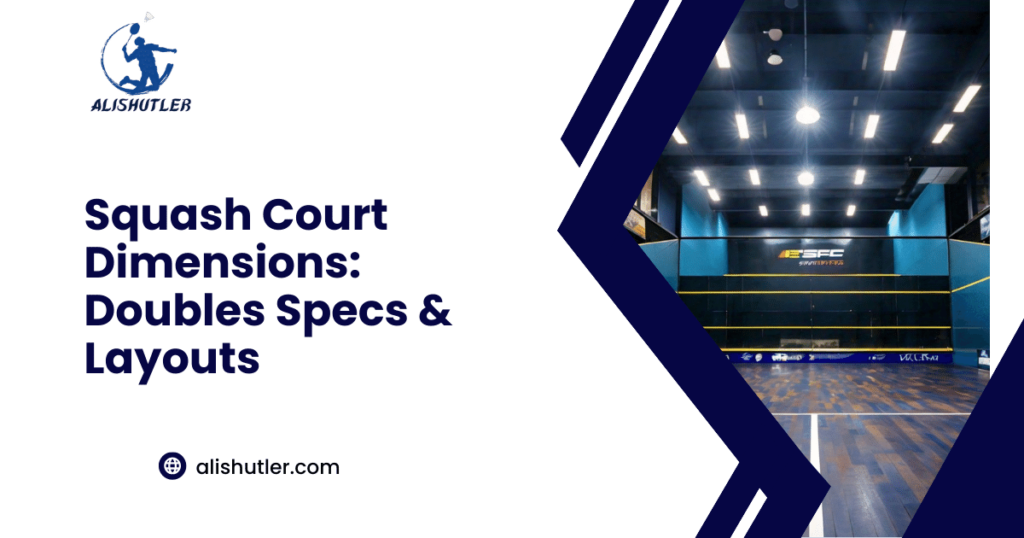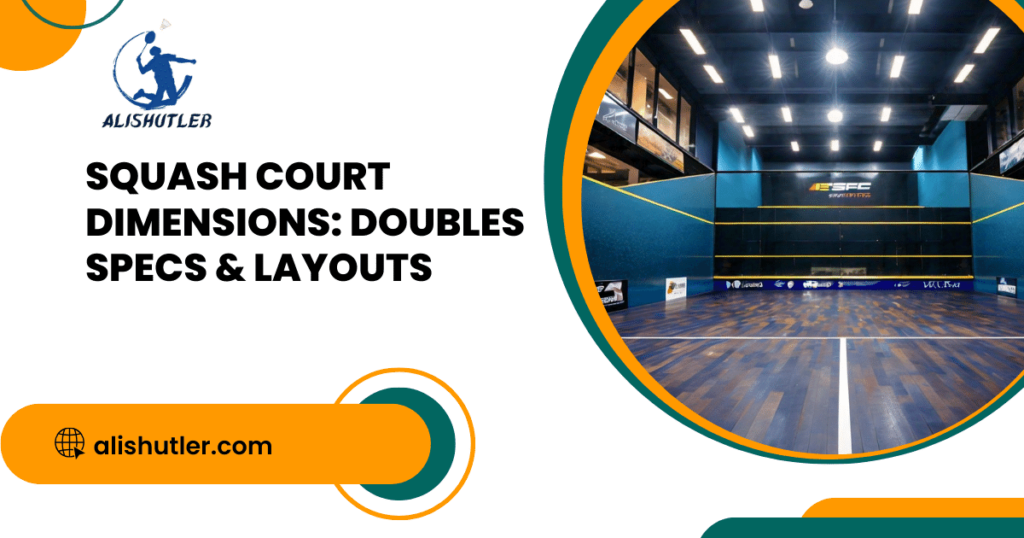Curious about squash court dimensions? Ever wondered how much space is needed for a regulation court? Dive into this guide for all the essential details. From length and width measurements in inches and meters to the importance of accurate sizing, understanding these dimensions is key to enjoying the game to its fullest. Get ready to ace your knowledge of squash court specifications!
Key Takeaways
- Know the Standard Dimensions: Understanding the dimensions of a squash court is crucial for players and facility managers to ensure proper gameplay and adherence to regulations.
- Differentiate Singles and Doubles Courts: Recognize the distinctions between singles and doubles squash courts to accommodate the specific needs of each game format, including space requirements and layout differences for individual sports and racket sports, catering to the skills of athletes.
- Emphasize Floor Markings: The correct placement and visibility of floor markings on a squash court are essential for players to follow game rules accurately and maintain a fair and competitive environment.
- Follow Official Guidelines: Referencing sports association details and official regulations regarding squash court dimensions is key to guaranteeing that facilities meet industry standards and provide a suitable playing environment.
- Maintain Safety and Fairness: By adhering to the specified court dimensions and markings, players can enjoy a safe and fair game, reducing the risk of injuries and disputes during matches.
- Regularly Check Compliance: Periodically reviewing and confirming that the squash court dimensions and markings align with the standard requirements outlined by relevant sports associations is vital for upholding the integrity of the game.
Understanding Squash Court Dimensions
Length and Width
A singles squash court, common in racket sports and individual sports, typically measures 32 feet in length and 21 feet in width. The dimensions are crucial for maintaining fair play and ensuring players have enough space to move around.
Importance of Court Height
The height of a squash sports court is equally important, with the front wall reaching 15 feet. This measurement ensures that players can hit the ball within a reasonable distance from the ground, adding an element of challenge and skill to the game.
Significance of Diagonal Measurements
The diagonal measurements of a squash court play a key role in determining the overall playing area. The distance from corner to corner is approximately 40 feet, creating strategic angles for shots and movements during gameplay.
Essential Features of a Singles Squash Court

Front Wall Dimensions
The front wall in a singles squash court is 6.4 meters long and 4.57 meters high, playing a crucial role in the game. It serves as the primary target for players’ shots, demanding precision and accuracy.
Back Wall Characteristics
The back wall in a singles squash court is where players must anticipate rebounds, requiring quick reflexes and strategic positioning. Its smooth surface ensures consistent ball bounces, challenging players to adapt swiftly during rallies.
Role of Side Walls
Side walls in a singles squash court define the playing area’s lateral boundaries, influencing shot angles and strategies. Players utilize these walls for bank shots, adding an element of surprise to outmaneuver opponents.
- Pros
- Facilitates strategic gameplay
- Enhances player agility and adaptability
- Cons
- Requires precise control to avoid errors
Doubles Squash Court Specifications
Size Comparison
A doubles squash court is significantly larger than a singles court, measuring 32 feet in length and 21 feet in width, compared to the 25 feet by 21 feet dimensions of a singles court. The increased length allows for more movement space accommodating four players.
The additional width in a doubles squash court ensures that there is ample room for two pairs of players to move around without hindering each other’s gameplay. In contrast, a singles court has limited lateral space, requiring only two players to navigate the area effectively.
Adjustments for Two Pairs
To accommodate the extra players on a doubles squash court, the front wall service line is pushed back from 15 feet to 19 feet. This adjustment provides sufficient space for all four players to position themselves strategically during serves and rallies.
The increase in court size alters the dynamics of gameplay in doubles squash by placing emphasis on team coordination, communication, and shot placement. With more significant areas to cover, players need to work together efficiently to cover the court effectively and exploit their opponents’ weaknesses.
Importance of Floor Markings

Positioning and Purpose
Floor markings play a crucial role in guiding player movement during a squash match. The back wall line helps players understand the court boundaries, preventing them from hitting the ball out of bounds. The short line indicates the position where serves must land to be considered legal.
The short line, located halfway between the back wall and the front wall, dictates where serves should bounce before reaching the opponent. This positioning ensures fair play by requiring serves to reach a minimum distance before being returned. On the other hand, the half court line divides the court into two equal halves, assisting players in maintaining their positions strategically during rallies.
Strategic Elements of Service Boxes
The service boxes, positioned diagonally across from each other at the front corners of the court, add depth to serving strategies in squash. By serving from specific areas within these boxes, players can control the angle and direction of their serves effectively. This strategic placement allows players to vary their serves, keeping opponents guessing and creating opportunities to gain an advantage in the match.
Reference and Sports Association Details
Guidelines for Squash Court Dimensions
To find official squash court dimension guidelines, individuals can refer to recognized sports associations that govern and regulate the specifications. These guidelines ensure fair play and standardization in individual sports competitions.
Prominent Sports Associations
- The World Squash Federation (WSF) is a key organization overseeing racket sports like squash, setting standards for court dimensions globally.
- National squash associations, such as US Squash or England Squash, also play a crucial role in maintaining consistent court sizes.
Adhering to standardized court dimensions is essential for maintaining fairness and consistency in athletes’ performances. By following these regulations, players can develop their skills effectively without facing discrepancies due to varying court sizes.
Summary of Squash Court Dimensions
Understanding the dimensions of a squash court is vital for players and enthusiasts like you. Whether it’s the singles or doubles court specifications, knowing these details ensures a fair and enjoyable game. Pay attention to the essential features and floor markings as they significantly impact your gameplay, strategy, and overall experience on the court. Referencing official sports associations can provide you with accurate information for your next match or training session.

Now that you have a solid grasp of squash court dimensions and their importance, take this knowledge onto the court with you. Apply these insights to enhance your game, communicate effectively with fellow players, and ensure a level playing field. Stay informed, play smart, and enjoy every moment on the squash court!
Frequently Asked Questions
What are the standard dimensions of a squash court?
The standard dimensions of a singles squash court are 32 feet in length, 21 feet in width, and 15 feet in height. These measurements ensure fair and competitive gameplay for all players.
Are there specific features that distinguish singles and doubles squash courts?
Yes, singles squash courts typically have a service box at the back whereas doubles squash courts have two service boxes at the back. This design variation caters to the different gameplay dynamics of singles and doubles matches.
Why are floor markings important in a squash court?
Floor markings serve as guidelines for players during gameplay, helping them understand boundaries, service areas, and other crucial zones. Clear floor markings enhance safety, fair play, and overall game efficiency.
Where can I find official references and details regarding squash court specifications?
Official references and detailed specifications for squash courts can be obtained from recognized sports associations such as the World Squash Federation or national squash federations. These organizations provide accurate guidelines for constructing and maintaining squash courts.
How do I ensure compliance with regulations when setting up a squash court?
To ensure compliance with regulations when setting up a squash court, it is essential to refer to the latest guidelines provided by reputable sports associations. Adhering to these regulations guarantees that your court meets professional standards for safe and fair gameplay.



